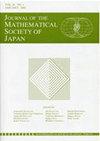关于拟对数格式
IF 0.7
4区 数学
Q2 MATHEMATICS
引用次数: 2
摘要
. 准对数格式的概念最早是由Florin Ambro在他划时代的论文《准对数变体》中提出的。本文建立了准对数格式的完全一般的Reid-Fukuda型无基点定理。粗略地说,这意味着Ambro论文中所宣称的准对数方案的所有结果都是正确的。该证明是Kawamata的x方法,并借助于基本的slc-平凡振动理论。为了方便读者,我们对拟对数格式的理论作了许多评论,以便使它更容易理解。本文章由计算机程序翻译,如有差异,请以英文原文为准。
On quasi-log schemes
. The notion of quasi-log schemes was first introduced by Florin Ambro in his epoch-making paper: Quasi-log varieties. In this paper, we establish the basepoint-free theorem of Reid–Fukuda type for quasi-log schemes in full generality. Roughly speaking, it means that all the results for quasi-log schemes claimed in Ambro’s paper hold true. The proof is Kawamata’s X-method with the aid of the theory of basic slc-trivial fibrations. For the reader’s convenience, we make many comments on the theory of quasi-log schemes in order to make it more accessible.
求助全文
通过发布文献求助,成功后即可免费获取论文全文。
去求助
来源期刊
CiteScore
1.40
自引率
0.00%
发文量
56
审稿时长
>12 weeks
期刊介绍:
The Journal of the Mathematical Society of Japan (JMSJ) was founded in 1948 and is published quarterly by the Mathematical Society of Japan (MSJ). It covers a wide range of pure mathematics. To maintain high standards, research articles in the journal are selected by the editorial board with the aid of distinguished international referees. Electronic access to the articles is offered through Project Euclid and J-STAGE. We provide free access to back issues three years after publication (available also at Online Index).

 求助内容:
求助内容: 应助结果提醒方式:
应助结果提醒方式:


